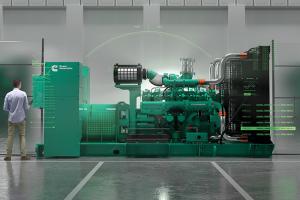CMMS software goes beyond record keeping

Photo courtesy of Accruent
At its most basic level, computerized maintenance management system (CMMS) software helps maintenance teams to keep a record of assets, schedule and track maintenance tasks, and maintain a historical record of the work they perform.
In hospitals, though, truly efficient CMMS software goes far beyond record keeping. It provides maintenance operations with opportunities to save time and money as well as to help collate vital information and generate accurate reports for audits.
Also, CMMS packages safely store schedules and records for regulatory audits and help the hospital with accreditation and certification.
Functionality requirements
When selecting CMMS software, health facility professionals should look for systems with a simple design and features that are specific to the health care environment, experts say. Hospital maintenance processes, compliance requirements and regulatory activities are unique and require an intimate understanding of the environment of care. Off-the-shelf systems that are not appropriate to this environment can be the cause of many data- and system-related issues.
A large percentage of health care facilities have had their CMMS packages for five years or more and they generally are not well-supported, according to Martyn Buffler, senior director of health care, client services, Dude Solutions Inc., Cary, N.C. “That’s why a new system with functionality built specifically for the health care environment, along with reporting capabilities and ease of use, will help to alleviate any frustration and drive timely utilization and adoption by users.”
Additionally, getting data in and out of the CMMS database has to be easy or it will not get used, according to Shawn Wright, principal, Smart Facility Software, Reno, Nev. “With so many data elements, the reports and dashboards needed for an employee, supervisor, system administrator or C-level executive are very different. An employee must be able to easily get base elements into the database, and an administrator must be able to pull data out with different levels of detail.”
Mobile devices
The integration of smartphone-based capabilities with CMMS software is a key trend that is driving system improvements. In fact, mobile devices have revolutionized the way technicians can interact with CMMS as well as the assets and buildings under their management. “The ability to receive real-time updates about issues improves productivity,” Buffler says. “Scanning bar-coded assets and having the work history at one’s fingertips means not having to do the same fix over and over.
“Less obvious to daily workflow, mobile technology enables instant access to online videos that can assist with problem solving, to supplier order forms and to immediate communication with contractors,” Buffler adds. “By having all of these tools on a handheld device, technicians are empowered to make better decisions faster, and have quick access to the resources they need to do the best job possible.”
The use of handheld devices can expedite inspections and spot checking of various operations, adds Harshad Shah, CEO and president, Eagle Technology Inc., Mequon, Wis. “Most health care facilities have implemented high-speed Wi-Fi to allow the use of handheld devices, which eliminate paper flow and allow for preventive maintenance, inspections and work orders to be recorded on demand. In addition, mobile-enabled CMMS packages provide the freedom to get updates in the field so that maintenance employees can focus on their work.”
The importance of mobile-based CMMS applications depends on the organization’s emphasis on its benefits, notes Rick Joslin, senior adviser, health care strategy, Accruent, Austin, Texas. “Many facilities do not mandate real-time work processing, thus relegating mobile capabilities to scheduled activities. These facilities will reap minimal benefits from mobile platforms. However, if the organization is willing to enforce real-time, last-in-first-out processes, the availability of real-time data is a game-changer.”
‘Internet of things’ connections
The “internet of things” is expanding hospital CMMS capabilities, as it creates ease of access to critical data. “In the past, CMMS in hospitals functioned primarily as repository systems for work orders that were separate from other systems,” says Rich Sable, product manager, EQ2 LLC, Charlotte, N.C. “As additional technologies impacted by the internet of things have evolved within the hospital setting, so, too, has CMMS. Now the more advanced CMMS offerings are robust solutions that are interconnected with other applications.
“The opportunities for integrations among different technologies have increased rapidly,” Sable adds. “For example, we have numerous integrations that allow different applications to be accessed through our CMMS. Our hospital equipment management system (HEMS) has built-in intelligence that makes capital budget planning and maintaining regulatory compliance easier. Also, connecting to technology through the cloud is now common.”
Finally, the evolution of the Integrating the Healthcare Enterprise — Patient Care Device profiles, which are sponsored by the American College of Clinical Engineering, the Health Information Management Systems Society and the Association for the Advancement of Medical Instrumentation, enables CMMS software to provide important information from medical devices, Sable says.
“HEMS receives error codes from devices and automatically assigns a specific technician to address the problem through a work order,” Sable says. “This means that overall life-cycle management and maintenance of devices improve. Also, medical devices communicate to HEMS information about utilization, software version, OS version, media access control address and Internet Protocol address.”
Ben Mannisto, president and CEO, Phoenix Data Systems Inc., Southfield, Mich., says the internet of things is having a substantial impact on CMMS software in health care. In fact, with medical device security risks on the rise, the internet of things integration has become the focal point of cybersecurity in hospitals. “Cybersecurity issues of interconnected, critical medical devices (such as heart monitors and IV pumps) must be managed in granular detail,” he says. “The best place for data on anything connected to medical equipment is within CMMS.”
Matt Weasel Jr., strategic account executive, Ashcom Technologies Inc., Ann Arbor, Mich., agrees that the security of internet-of-things devices is a high priority, particularly in the medical field. “As the security of these devices is proven, there will be wider adoption,” Weasel says. “Our company is working on ways to integrate with proven devices to provide access to this critical real-time data.”
New CMMS software can meet the needs of small, off-campus health care facilities as well as large hospitals. For example, Ashcom Technologies designed its MaintiMizer enhanced multibusiness unit as an easy addition to the core site installation. “This allows smaller facilities to take advantage of the best-in-class features of MaintiMizer without having to go through another implementation process. Facilities can share or segregate as much of the information as they would like,” Weasel says.
Sable says that many small, off-campus facilities require a mobile application to be used by their service engineers. Because of the remote locations, there is no guarantee that network resources will be available, so the mobile product must work in a dual modality: network connected and non-network connected. “In all cases, the engineers need to be able to document both their corrective and scheduled work in the field and have that data uploaded to the main database,” he says.
Because off-campus facilities have smaller operating budgets, there is concern over the costs of using a powerful software product, Sable adds. One way that a CMMS provider can help is by offering a SaaS (software as a service, or cloud) solution. “In fact, with a SaaS model, the customer is not placing further demands on the IT department and doesn’t have to absorb the cost of building an infrastructure on-site,” he says. “For example, our EQ2 SaaS solution utilizes virtualized servers in a secure and robust Microsoft Azure environment.”
Other innovations
Among CMMS software recently introduced to the health care market, Accruent’s Connectiv platform features built-in application programming interfaces that allow health facility professionals to collate data from multiple systems, allowing real-time decision-making. The included workflow engines allow users to implement automated processes. “The customizable screens and data points mean users can get the right CMMS to fit their needs,” Joslin says. “Also, multiplatform usability ensures availability regardless of the hardware platform.”
Dude Solutions offers TheWorxHub for health care, which is designed to help manage the fast-paced, regulatory-driven and on-demand environments of hospitals. Over the past three years, the company has introduced a suite of features that tackle important issues facing hospitals, including the latest update that supports survey readiness and compliance.
“This new functionality will reference The Joint Commission and National Fire Protection Association codes in the system, allowing users to preview requirements while working, link the codes to assets and tasks, and demonstrate proof of compliance to surveyors and regulatory bodies by rolling up reporting against any standard or element of performance,” Buffler says.
Eagle Technology Inc.’s suite of Proteus CMMS software provides an asset-management solution as well as preventive-maintenance scheduling capabilities. It also integrates with most building automation systems (BAS). BAS integration monitors alerts or anomalies and automatically creates a work order. “It has helped customers better organize their maintenance programs,” Shah says.
Proteus CMMS software is designed to increase the life and reliability of vital assets such as HVAC systems, lights, plumbing and elevators, Shah says. Preventive-maintenance scheduling also keeps such medical equipment as MRI and X-ray machines working at optimum condition, he adds.
Phoenix Data Systems Inc. recently introduced two applications for its asset information-management system (AIMS) that focus on mobility, operational efficiency and cost containment. The AIMS EasyNet Touch facilitates work requests submitted by clinicians, medical staff and biomedical engineering staff from various hospital departments. Smartphones and tablets are used to create, submit and monitor the status of work requests.
The second AIMS application expands on mobile technology that is available today. In addition to the ability to perform basic tasks in the field, such as updating work orders and looking up equipment information, technicians are able to harness mobile-device features like expanded bar code scanning, camera integration, voice-to-text, push notifications and a GPS locator service.
In 2017, Smart Facility Software released ES Service Optimizer, a companion app for its ES Optimizer tool. “For years, environmental services (ES) managers have been using this tool to analyze staffing needs, build and manage daily work assignments and run quality-assurance inspections,” Wright says. “Now, as more ES departments adopt mobile devices, ES Service Optimizer has been upgraded to connect the entire team, including ES techs, to this task-management system via cloud-based, mobile technology.”
Featuring a mobile communications platform, ES Service Optimizer offers real-time, task management, which allows supervisors to schedule and assign tasks, and customer service requests to be communicated via quick-response (QR) code scans. Using a smart device, staff can request service via QR scan signage posted in high-traffic areas. The ES manager receives the service request on a mobile device and can immediately alert a technician.
Points of security
Cybersecurity is the biggest CMMS issue today and for the foreseeable future, according to Mannisto. “With the continued integration of various third-party applications to CMMS software, the points of cybersecurity risk have increased,” he says.
CMMS software is the best place to identify and manage cybersecurity issues emanating from these system integrations. “Therefore, it is incumbent upon CMMS providers to offer superior management of integrated medical devices and compatibility with various cybersecurity-focused applications,” Mannisto concludes.
Neal Lorenzi is a freelance writer based in Mundelein, Ill.
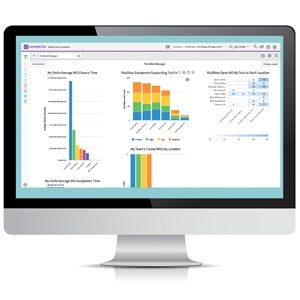
Tracking well
Connectiv Facilities Manager Dashboard provides an overview for managers, leaders and supervisors to track compliance and the status of critical issues. Accruent

Clean solution
An environmental services tech receives work assignments via the ES Service Optimizer mobile app. Smart Facility Software
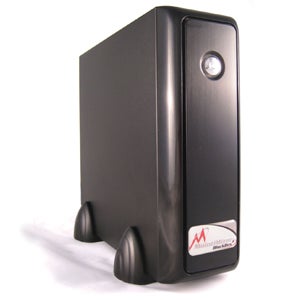
Mining data
MaintiMizer BlackBox² CMMS, a self-contained plug-and-play network appliance, helps hospitals to manage work orders, preventive maintenance schedules and tasks, assets, inventory, purchase orders and reports, and analyzes trends in data. Ashcom Technologies Inc.
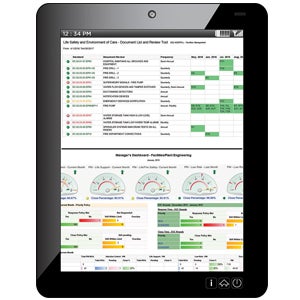
Rule keeper
HEMS CMMS helps hospitals to stay compliant through tracking and reporting features that address the environment of care, fire protection and critical utilities, and their respective Elements of Performance as set by The Joint Commission and other regulatory bodies. EQ2 LLC
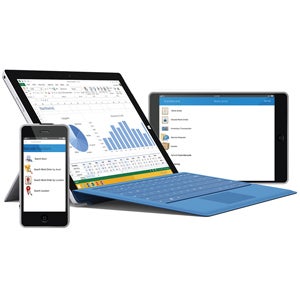
Asset manager
Proteus MMX Mobile helps field technicians record and track equipment for more accurate, efficient deployment. Eagle Technology Inc.
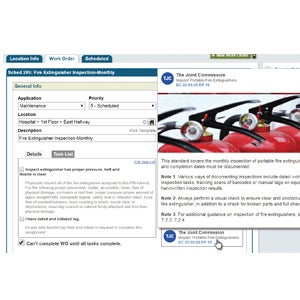
Staying compliant
TheWorxHub allows users to link work orders to a Joint Commission standard and task list and instantly generate reports against any standard or element of performance. Dude Solutions

Central location
EasyNet Touch facilitates work requests submitted by clinicians, medical staff and biomedical engineering staff from various hospital departments. Phoenix Data Systems Inc.


